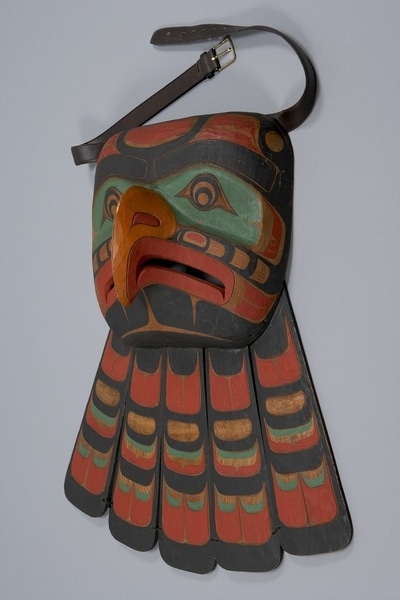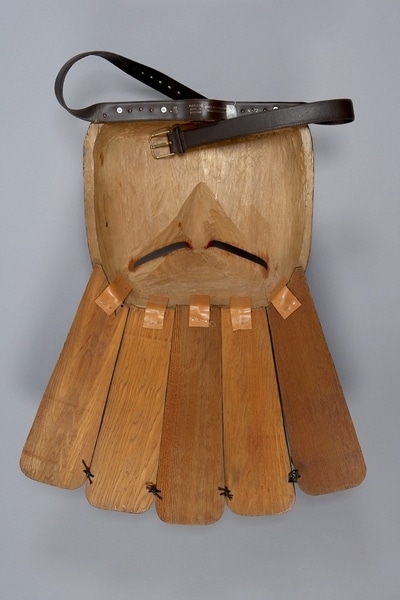Thunderbird Dance Panel Item Number: 863/3 from the MOA: University of British Columbia



Description
Carved tail panel. Painted wooden Thunderbird face with wooden slats below, belt above. The wooden face is mask-like, somewhat square with rounded corners. The features are painted in red, black and green with a protruding orange nose. Below the face are five wooden slats painted red and black with green details. Attached to the upper back edge of the wooden face is a brown leather belt with a gold-coloured buckle.
History Of Use
Thunderbird dance regalia (see four parts 863/1-4); worn in the dance displaying Hunt's inherited Thunderbird privileges.
Iconographic Meaning
The story of Thunderbird: "The Great Chief Namoquayalis, 'The Only One,' lived in the highest mountain, called Klaskis, near Cape Cook. At one time a flood threatened to engulf the world. Then lightning flashed four times, and a Thunderbird transformed himself into a human being and came to the rescue of the Great Chief. The Great Chief then asked the Thunderbird to go look around the land for any survivors of the flood. The Thunderbird returned and told him that he had found some human survivors. So the Great Chief told the Thunderbird to go and invite these people to come and witness a Thunderbird dance. This dance and the Thunderbird privileges have been passed down from generation to generation of the Great Chief’s family." [From a narration by Emma Hunt, 1975.]
Narrative
Calvin Hunt received the rights to the Thunderbird crest, legends, and regalia, along with other names and crests, from his parents Emma Hunt and Chief Thomas Hunt at a 1975 family potlatch. This regalia is one of several sets he has made and danced; it was commissioned by the Museum of Anthropology in 1982. The regalia was borrowed back by Hunt in 1984, 1987 and 1988 to be danced at Kwak'waka'wakw potlatches.
Item History
- Made by Calvin Hunt (Maker) in British Columbia, Canada during October 1982
- Owned by Calvin Hunt before October 17, 1982
- Received from Calvin Hunt (Seller) and Museum of Anthropology Shop Volunteers (Funding source) on October 17, 1982
What
Who
- Culture
- Kwakwaka'wakw
- Creator
- Calvin Hunt (Maker)
- Previous Owner
- Calvin Hunt
- Received from
- Calvin Hunt (Seller) and Museum of Anthropology Shop Volunteers (Funding source)
Where
- Holding Institution
- MOA: University of British Columbia
- Made in
- British Columbia, Canada
When
- Creation Date
- during October 1982
- Ownership Date
- before October 17, 1982
- Acquisition Date
- on October 17, 1982
Other
- Condition
- good
- Current Location
- Case 26
- Accession Number
- 0863/0003